Long-Term (2017–2020) Aerosol Optical Depth Observations in Hohhot City in Mongolian Plateau and the Impacts from Different Types of Aerosol
Abstract
:1. Introduction
2. Site, Instrument and Methodology
2.1. Site Description
2.2. CIMEL Sun-Photometer
2.3. MARGA System
2.4. OC/EC Online Analyzer
2.5. TrajStat Model
2.6. Wing Framework Methodology
3. Results
3.1. Statistical Analysis of AOD500 and α440-675
3.2. Backward Trajectory Clusters
- For spring, Type-1 trajectory, i.e., northwest air mass from long-range transport, came from Kazakhstan/Xinjiang Province (Zone II: Desert/Gobi, Figure 1), accounted for 46.37% of the total trajectories. This type of trajectory carried dust aerosols when passing through the Desert/Gobi areas, resulting in a relatively coarse mode of 0.73 ± 0.47 of α440-675, a slightly polluted scenario of 0.45 ± 0.40 of AOD500, and a seasonal highest Ca2+ fraction of 12% (Figure 4), the main component of dust aerosols. Type-2 trajectory, a north air mass from medium-range transport, originated from the Mongolian plateau, accounted for 35.75%. AOD500 under the influence of the north clean air mass was 0.30 ± 0.29. The Type-3 trajectory, i.e., the south air mass from short-range transport, was from Shanxi province. Although Type-3 has the lowest frequency of 17.88%, as well as the weakest wind speed in comparison with the other two air masses (2.36 m s−1 < 2.87 m s−1 < 2.95 m s−1), the highest aerosol loadings of 0.78 ± 0.46 of AOD500 and SO42− fraction of 18% were observed. The explanation is that the severe anthropogenic emissions accompanied by the fast urbanization and industrialization over zone IV (Figure 1a), especially for the SO2 emitted from the serried steel/coal enterprises in Shanxi Province, were transported to Hohhot city and led to heavy haze pollution. In consideration of PM2.5 values estimated by the sum of ionic composition and carbonaceous aerosols, concentrations were 34.80 μg m−3 (Type-3) > 25.96 μg m−3 (Type-1) > 22.14 μg m−3 (Type-2), which was consistent with the order of AOD500.
- For summer, the four types of air masses occurred with similar frequency of 24.23%, 21.17%, 29.14%, and 25.46%. AOD500 values under the control of Type-1 (Northwest air mass from long-range transport), Type-2 (North air mass from medium-range transport), and Type-3 (Northwest air mass from short-range transport) were 0.29 ± 0.17, 0.20 ± 0.15, and 0.31 ± 0.19. The corresponding PM2.5 concentrations were 16.23 μg m−3, 11.51 μg m−3, and 18.49 μg m−3, respectively. Similar with spring, the south air mass of Type-4 with the lowest wind speed comparing with the other three air masses (1.98 m s−1 < 2.24 m s−1 < 2.49 m s−1 < 2.06 m s−1) also resulted in a polluted scenario of 0.65 ± 0.42 of AOD500. SO42− concentrations in Type-1, Type-2, Type-3, and Type-4 were 21%, 16%, 24%, and 31%, respectively. It is observed that the summertime SO42− fractions for the four trajectories were higher than the other seasons. The strong solar radiation and high temperature were catalysts to promote the transformation of SO2 to SO42− and the reason for the highest fraction of 31% in south air mass Type-4 (Figure 4b) was the same as that of Type-3 of spring.
- For autumn, the Type-1 trajectory, i.e., Northwest air mass from medium-range transport, originated from Mongolia and accounted for 23.42%; Type-3 trajectory, i.e., West air mass from long-range transport, came from Kazakhstan and had a frequency of 40.19%. The local air masses of Type-2 occupied 36.29% and the AOD500 of 0.46 ± 0.41 was more severe in comparison with Type-1 (0.24 ± 0.29) and Type-3 (0.33 ± 0.35) due to the high local anthropogenic emissions of Hohhot city. This is also evidenced from the largest fraction of 20% of NO3− (Type-2: 20% > Type-3: 14% > Type-1: 11%) (Figure 4c).
- For winter, the west group trajectories of Type-1, Type-2, and Type-3, originated from Inner Mongolia, Kazakhstan, and Xinjiang province, respectively, and had a total frequency of 71.30% (17.98% + 14.20% + 39.12%). Slightly polluted scenarios of AOD500 of 0.52 ± 0.43, 0.50 ± 0.40, and 0.40 ± 0.35, PM2.5 of 54.73 μg m−3, 58.39 μg m−3, and 50.85 μg m−3, and similar chemical composition proportion (Figure 4d) were observed for these three types of air masses. Wintertime coal combustion for home heating was very common in rural villages of Inner Mongolia, in conjunction with the heavy industries in Baotou, Wuhan, located to the west of Hohhot, the severe emission of SO2 transported by the west group trajectories led to high proportions of SO42− of 21% (Type-1), 20% (Type-2), and 20% (Type-3). The Type-4 trajectory, i.e., North air mass from long-range transport, had the lowest frequency of 8.20% and the highest wind speed of 3.19 m s−1, under which, the aerosol loading was as low as 0.13 ± 0.08 and the surface PM2.5 was 23.86 μg m−3; Type-5 trajectory, i.e., Northwest air mass from long-range transport, accounts for 20.50% and the aerosol loading of AOD500 of 0.19 ± 0.13 and surface PM2.5 of 34.03 μg m−3 were also very low. The fraction of organic matter (OM) accounts for 44% and 42% in these two trajectories.
3.3. Wing Framework Methodology for Aerosol Type Classification
4. Conclusions
- (1)
- The air quality in Hohhot city was slightly polluted during the years 2017–2020, with a mixed type of coarse-mode dust aerosol and fine-mode urban/industrial aerosol. Significant seasonal characteristics were observed for the aerosol optical depth. The aerosol loading in spring was higher than that of summer, autumn, and winter due to the frequent dust events.
- (2)
- Throughout the year, depopulated-zone continental air flows originating from NW-quadrant were dominant over Hohhot. The clean and strong NW-quadrant air flows induced by the southern movement of the Siberian anticyclone resulted in low aerosol loading, while the local emissions, as well as southern and western transport of anthropogenic fine-mode urban/industrial aerosol in the four seasons, contributed to the high aerosol loading associated with significant transformation of secondary aerosols.
- (3)
- Dust aerosols suspended in urban Hohhot all year and larger fine mode particles contributed to higher aerosol extinction. Severe dust storms accompanied with high Ca2+/WSIIs of >40% distributed in the domain of {δα > 0, η < 30%} mainly occurred in the Type-1 trajectory in spring, while the dust events appearing in other trajectories appeared to be less frequent and weaker (20% < Ca2+/WSIIs < 40%).
Author Contributions
Funding
Data Availability Statement
Acknowledgments
Conflicts of Interest
References
- Zheng, Z.F.; Zhao, C.; Lolli, S.; Wang, X.D.; Wang, Y.T.; Ma, X.Y.; Li, Q.C.; Yang, Y.J. Diurnal Variation of Summer Precipitation Modulated by Air Pollution: Observational Evidences in the Beijing Metropolitan Area. Environ. Res. Lett. 2020, 15, 094053. [Google Scholar] [CrossRef]
- Zong, L.; Yang, Y.J.; Gao, M.; Wang, H.; Wang, P.; Zhang, H.L.; Wang, L.L.; Ning, G.C.; Liu, C.; Li, Y.B.; et al. Large-scale synoptic drivers of co-occurring summertime ozone and PM2.5 pollution in eastern China. Atmos. Chem. Phys. 2021, 21, 9105–9124. [Google Scholar] [CrossRef]
- Che, H.Z.; Yang, Z.F.; Zhang, X.Y.; Zhu, C.Z.; Mac, Q.L.; Zhou, H.G.; Wang, P. Study on the aerosol optical properties and their relationship with aerosol chemical compositions over three regional background stations in China. Atmos. Environ. 2009, 43, 1093–1099. [Google Scholar] [CrossRef]
- Dubovik, O.; Smirnov, A.; Holben, B.N.; King, M.D.; Kaufman, Y.J.; Eck, T.F. Accuracy assessments of aerosol optical properties retrieved from Aerosol Robotic Network (AERONET) Sun and sky radiance measurements. J. Geophys. Res. 2000, 105, 9791–9806. [Google Scholar] [CrossRef] [Green Version]
- Stocker, T.F.; Qin, D.; Plattner, G.-K.; Tignor, M.M.H.L.; Simon, A.K.; Boschung, J.; Nauels, A.; Xia, Y.; Bex, B.; Midgley, B.M. IPCC 2013: Climate Change 2013: The Physical Science Basis. Contribution of Working Group I to the Fifth Assessment Report of the Intergovernmental Panel on Climate Change; Cambridge University Press: Cambridge, UK, 2013. [Google Scholar]
- Zhao, D.D.; Xin, J.Y.; Gong, C.S.; Quan, J.N.; Wang, Y.S.; Tang, G.Q.; Ma, Y.X.; Dai, L.D.; Wu, X.Y.; Liu, G.J.; et al. The impact threshold of the aerosol radiative forcing on the boundary layer structure in the pollution region. Atmos. Chem. Phys. 2021, 21, 5739–5753. [Google Scholar] [CrossRef]
- Ma, Y.J.; Ye, J.H.; Xin, J.Y.; Zhang, W.Y.; Vilà-Guerau de Arellano, J.; Wang, S.G.; Zhao, D.D.; Dai, L.D.; Ma, Y.X.; Wu, X.Y.; et al. The Stove, Dome, and Umbrella Effects of Atmospheric Aerosol on the Development of the Planetary Boundary Layer in Hazy Regions. Geophy. Res. Lett. 2020, 47, e2020GL087373. [Google Scholar] [CrossRef]
- Ma, Y.J.; Xin, J.Y.; Wang, Z.F.; Tian, Y.L.; Wu, L.; Tang, G.Q.; Zhang, W.Y.; Vilà-Guerau de Arellano, J.; Zhao, D.D.; Jia, D.J.; et al. How do aerosols above the residual layer affect the planetary boundary layer height? Sci. Total Environ. 2022, 814, 151953. [Google Scholar] [CrossRef]
- Kong, L.B.; Xin, J.Y.; Zhang, W.Y.; Wang, Y.S. The empirical correlations between PM2.5, PM10 and AOD in the Beijing metropolitan region and the PM2.5, PM10 distributions retrieved by MODIS. Environ. Pollut. 2016, 216, 350–360. [Google Scholar] [CrossRef]
- Wang, L.L.; Xin, J.Y.; Wang, Y.S.; Li, Z.Q.; Liu, G.R.; Li, J. Evaluation of the MODIS aerosol optical depth retrieval over different ecosystems in China during EAST-AIRE. Atmos. Environ. 2007, 41, 7138–7149. [Google Scholar] [CrossRef]
- Wang, L.L.; Wang, Y.S.; Xin, J.Y.; Li, Z.Q.; Wang, X.Y. Assessment and comparison of three years of Terra and Aqua MODIS aerosol. Atmos. Res. 2010, 97, 229–240. [Google Scholar] [CrossRef]
- Wang, H.; Li, J.W.; Gao, Z.Q.; Yim, S.H.L.; Shen, H.F.; Ho, H.C.; Li, Z.Y.; Zeng, Z.L.; Liu, C.; Li, Y.B.; et al. High-Spatial-Resolution Population Exposure to PM2.5 Pollution Based on Multi-Satellite Retrievals: A Case Study of Seasonal Variation in the Yangtze River Delta, China in 2013. Remote Sens. 2019, 11, 2724. [Google Scholar] [CrossRef] [Green Version]
- Tian, P.F.; Cao, X.J.; Zhang, L.; Sun, N.X.; Sun, L.; Logan, T.; Shi, J.S.; Wang, Y.; Ji, Y.M.; Lin, Y.; et al. Aerosol vertical distribution and optical properties over China from long-term satellite and ground-based remote sensing. Atmos. Chem. Phys. 2017, 17, 2509–2523. [Google Scholar] [CrossRef] [Green Version]
- Che, H.Z.; Zhang, X.Y.; Xia, X.A.; Goloub, P.; Holben, B.; Zhao, H.; Wang, Y.; Zhang, X.-C.; Wang, H.; Blarel, L.; et al. Ground-based aerosol climatology of china: Aerosol optical depths from the china aerosol remote sensing network (CARSNET) 2002–2013. Atmos. Chem. Phys. 2015, 15, 7619–7652. [Google Scholar] [CrossRef] [Green Version]
- Xin, J.Y.; Wang, Y.S.; Li, Z.Q.; Wang, P.C.; Hao, W.M.; Bryce Nordgren, L.; Wang, S.G.; Liu, G.R.; Wang, L.L.; Wen, T.X.; et al. Aerosol optical depth (AOD) and Ångström exponent of aerosols observed by the chinese sun hazemeter network from August 2004 to September 2005. J. Geophys. Res. 2007, 27, 1703–1711. [Google Scholar] [CrossRef]
- Xin, J.Y.; Wang, Y.S.; Pan, Y.P.; Ji, D.S.; Liu, Z.R.; Wen, T.X.; Wang, Y.H.; Li, X.R.; Sun, Y.; Sun, J.; et al. The campaign on atmospheric aerosol research network of china: Care-china. Bull. Am. Meteorol. Soc. 2015, 96. [Google Scholar] [CrossRef]
- Chen, J.S.; Xin, J.Y.; An, J.L.; Wang, Y.S.; Liu, Z.R.; Chao, N.; Meng, Z. Observation of aerosol optical properties and particulate pollution at background station in the Pearl River Delta region. Atmos. Res. 2014, 143, 216–227. [Google Scholar] [CrossRef]
- Xin, J.Y.; Wang, L.L.; Wang, Y.S.; Li, Z.Q.; Wang, P.C. Trends in aerosol optical properties over the Bohai Rimin Northeast China from 2004 to 2010. Atmos. Environ. 2011, 45, 6317–6325. [Google Scholar] [CrossRef]
- Xin, J.Y.; Zhang, Q.; Gong, C.S.; Wang, Y.S.; Du, W.P.; Zhao, Y.F. Aerosol direct radiative forcing over Shandong Peninsula in East Asia from 2004 to 2011. Atmos. Ocean Sci. Lett. 2014, 7, 74–79. [Google Scholar]
- Zhao, H.J.; Che, H.Z.; Ma, Y.J.; Xia, X.A.; Wang, Y.F.; Wang, P.; Wu, X.C. Temporal variability of the visibility, particulate matter mass concentration and aerosol optical properties over an urban site in Northeast China. Atmos. Res. 2015, 166, 204–212. [Google Scholar] [CrossRef]
- Ma, Y.J.; Xin, J.Y.; Zhang, W.Y.; Wang, Y.S. Optical properties of aerosols over a tropical rain forest in Xishuangbanna, South Asia. Atmos. Res. 2016, 178, 187–195. [Google Scholar] [CrossRef]
- Ma, Y.J.; Xin, J.Y.; Ma, Y.N.; Kong, L.B.; Zhang, K.Q.; Zhang, W.Y.; Wang, Y.S.; Wang, X.Q.; Zhu, Y.F. Optical properties and source analysis of aerosols over a desert area in Dunhuang, Northwest China. Adv. Atmos. Sci. 2017, 34, 1017–1026. [Google Scholar] [CrossRef]
- Ma, Y.N.; Xin, J.Y.; Zhang, W.Y.; Liu, Z.R.; Ma, Y.J.; Kong, L.B.; Wang, Y.S.; Deng, Y.; Lin, S.H.; He, Z.M. Long-term variations of the PM2.5 concentration identified by MODIS in the tropical rain forest, Southeast Asia. Atmos. Res. 2018, 219, 140–152. [Google Scholar] [CrossRef]
- Su, H.J.; Xin, J.Y.; Ma, Y.J.; Liu, Z.R.; Wen, T.X.; Wang, S.G.; Fan, G.Z.; Li, W.; Wang, L.; He, Z.M.; et al. Effects of transport on aerosols over the eastern slope of the Tibetan Plateau: Synergistic contribution of Southeast Asia and the Sichuan Basin. Atmos. Ocean Sci. Lett. 2018, 11, 425–431. [Google Scholar] [CrossRef] [Green Version]
- Zhao, D.D.; Xin, J.Y.; Gong, C.S.; Wang, X.; Ma, Y.J.; Ma, Y.N. Trends of aerosol optical properties over the heavy industrial zone of northeastern Asia in the past decade (2004–2015). J. Atmos. Sci. 2018, 75, 1741–1754. [Google Scholar] [CrossRef]
- Ma, Y.N.; Xin, J.Y.; Zhang, W.Y.; Gong, C.S.; Wen, T.X.; Wu, X.Y.; Wang, Y.S.; Wang, L.L.; Wu, F.K.; Ding, X. Uncertainties of simulated aerosol direct radiative effect induced by aerosol chemical components: A measurement-based perspective from urban-forest transition region in east china. J. Geophys. Res. 2021, 126, e2020JD033688. [Google Scholar] [CrossRef]
- Ren, X.B.; Xin, J.Y.; Wu, J.S.; Gong, C.S.; Gao, W.K.; Zhao, D.D.; Ma, Y.J. The relationship between PM 2.5 pollution and aerosol radiative forcing in a heav y industrial city, Taiyuan, in China. Atmos. Res. 2021, 267, 105935. [Google Scholar] [CrossRef]
- Shao, P.; Xin, J.Y.; Zhang, X.L.; Gong, C.S.; Ma, Y.J.; Wang, Y.S.; Wang, S.G.; Hu, B.; Ren, X.B.; Wang, B.Y. Aerosol optical properties and their impacts on the co–occurrence of surface ozone and particulate matter in Kunming City, on the Yunnan–Guizhou Plateau of China. Atmos. Res. 2021, 266, 105963. [Google Scholar] [CrossRef]
- Zhang, K.Q.; Ma, Y.J.; Xin, J.Y.; Liu, Z.R.; Ma, Y.N.; Gao, D.D.; Wu, J.S.; Zhang, W.Y.; Wang, Y.S.; Shen, P.K. The aerosol optical properties and PM2.5 components over the world’s largest industrial zone in tangshan, north china. Atmos. Res. 2018, 201, 226–234. [Google Scholar] [CrossRef]
- He, Q.S.; Li, C.C.; Geng, F.H.; Yang, H.Q.; Li, P.R.; Li, T.T.; Li, D.W.; Pei, Z. Aerosol optical properties retrieved from Sun photometer measurements over Shanghai, China. J. Geophys. Res. 2012, 117, D16204. [Google Scholar] [CrossRef] [Green Version]
- Na, K.; Kumar, K.R.; Yu, X.N.; Yin, Y. Column-integrated aerosol optical properties and direct radiative forcing over the urban-industrial megacity Nanjing in the Yangtze River Delta, China. Environ. Sci. Pollut. Res. 2016, 23, 17532–17552. [Google Scholar]
- Wang, L.C.; Gong, W.; Xia, X.A.; Zhu, J.; Li, J.; Zhu, Z.M. Long-term observations of aerosol optical properties at Wuhan, an urban site in Central China. Atmos. Environ. 2014, 101, 94–102. [Google Scholar] [CrossRef]
- Wu, X.Y.; Xin, J.Y.; Zhang, W.Y.; Gong, C.S.; Ma, Y.N.; Ma, Y.J.; Wen, T.X.; Liu, Z.R.; Tian, S.L.; Wang, Y.S.; et al. Optical, Radiative and Chemical Characteristics of Aerosol in Changsha City, Central China. Adv. Atmos. Sci. 2020, 37, 1310–1322. [Google Scholar] [CrossRef]
- Mao, J.D.; Sheng, H.J.; Zhao, H.; Zhou, C.Y. Observation Study on the Size Distribution of Sand Dust Aerosol Particles over Yinchuan, China. Adv. Meteorol. 2015, 2014, 1–7. [Google Scholar] [CrossRef]
- Zhu, J.; Xia, X.A.; Che, H.Z.; Wang, J.; Zhang, J.; Duan, Y. Study of aerosol optical properties at Kunming in southwest China and long-range transport of biomass burning aerosols from North Burma. Atmos. Res. 2015, 169, 237–247. [Google Scholar] [CrossRef]
- Eck, T.F.; Holben, B.N.; Reid, J.S.; Dubovik, O.; Smirnov, A.; O’Neill, N.T.; Slutsker, I.; Kinne, S. Wavelength dependence of the optical depth of biomass burning, urban, and desert dust aerosols. J. Geophys. Res. 1999, 104, 31333–31349. [Google Scholar] [CrossRef]
- Kasten, F. A new table and approximate formula for relative optical air mass. Arch. Meteorol. Geophys. Bioclimatol. 1966, 14, 206–233. [Google Scholar] [CrossRef]
- Kasten, F.; Young, A.T. Revised optical air mass tables and approximation formula. Appl. Opt. 1989, 28, 4735–4738. [Google Scholar] [CrossRef]
- Komhyr, W.D.; Mateer, C.L.; Hudson, R.D. Operations handbook—Ozone observations with a Dobson Spectrophotometer. In WMO Global Ozone Research and Monitoring Project 1980, Report No.6; WMO: Geneva, Switzerland, 1980. [Google Scholar]
- Fröhlich, C.; Shaw, G.E. New determination of Rayleigh scattering in the terrestrial atmosphere. Appl. Opt. 1980, 19, 1773–1775. [Google Scholar] [CrossRef]
- Ångström, A. The parameters of atmospheric turbidity. Tellus 1964, 16, 64–75. [Google Scholar] [CrossRef] [Green Version]
- Rumery, I.C.; Cowen, K.A.; Walker, J.T.; Kelly, T.J.; Hanft, E.A.; Mishoe, K.; Roers, C.; Proost, R.; Beachley, G.M.; Lear, G.; et al. Anassessment of the performance of the Monitor for AeRosols and Gases in ambient air (MARGA): A semi-continuous method for soluble compounds. Atmos. Chem. Phys. 2014, 14, 5639–5658. [Google Scholar]
- Chen, X.; Walker, J.T.; Geron, C. Chromatography related performance of the Monitor for AeRosols and Gases in ambient air (MARGA): Laboratory and field-based evaluation. Atmos. Meas. Tech. 2017, 10, 3893–3908. [Google Scholar] [CrossRef] [PubMed] [Green Version]
- Birch, M.E.; Cary, R.A. Elemental carbon-based method for monitoring occupational exposures to particulate diesel exhaust. Aerosol Sci. Technol. 1996, 25, 221–241. [Google Scholar] [CrossRef]
- Pang, B.; Ji, D.S.; Liu, Z.R.; Zhu, B.; Wang, Y.S. Comparison of Monitoring Methods of Organic Carbon and Element Carbon in Atmospheric Fine Particles. Environ. Sci. 2016, 37, 1230–1239. [Google Scholar]
- Standard Operating Procedure (SOP) For the Analysis of Organic and Elemental Carbon (OC/EC) Using the Sunset Laboratory Semi-Continuous Carbon Aerosol Analyzer. Available online: https://www.epa.gov/sites/default/files/2019-05/documents/sunset_sop_draft030212.pdf#:~:text=This%20Standard%20Operating%20Procedure%20%28SOP%29%20describes%20the%20operation%20in%20fine%20particulate%20matter%20%28PM%202.5%20ThePM%202.5 (accessed on 26 April 2022).
- Ram, K.; Sarin, M.M. Day–night variability of EC, OC, WSOC and inorganic ions in urban environment of Indo-Gangetic Plain: Implications to secondary aerosol formation. Atmos. Environ. 2011, 45, 460–468. [Google Scholar] [CrossRef]
- Huang, X.J.; Liu, Z.R.; Liu, J.Y.; Hu, B.; Wen, T.X.; Tang, G.Q.; Zhang, J.K.; Wu, F.K.; Ji, D.S.; Wang, L.L.; et al. Chemical characterization and source identification of PM2.5 at multiple sites in the Beijing-Tianjin-Hebei region, China. Atmos. Chem. Phys. 2017, 17, 12941–12962. [Google Scholar] [CrossRef]
- Wang, Y.; Wen, Y.P.; Cui, Y.; Guo, L.L.; He, Q.S.; Li, H.Y.; Wang, X.M. Substantial changes of chemical composition and sources of fne particles during the period of COVID-19 pandemic in Taiyuan, Northern China. Air Qual. Atmos. Health 2022, 15, 47–58. [Google Scholar] [CrossRef]
- Cao, J.J.; Lee, S.C.; Chow, J.C.; Watson, J.G.; Ho, K.F.; Zhang, R.J.; Jin, Z.D.; Shen, Z.X.; Chen, G.C.; Kang, Y.M.; et al. Spatial and seasonal distributions of carbonaceous aerosols over China. J. Geophys. Res. 2007, 112, D22S11. [Google Scholar] [CrossRef] [Green Version]
- Wang, Y.Q.; Zhang, X.Y.; Draxler, R.R. Trajstat: Gis-based software that uses various trajectory statistical analysis methods to identify potential sources from long-term air pollution measurement data. Environ. Model. Softw. 2009, 24, 938–939. [Google Scholar] [CrossRef]
- Gobbi, G.P.; Kaufman, Y.J.; Koren, I.; Eck, T.F. Classification of aerosol properties derived from AERONET direct sun data. Atmos. Chem. Phys. 2007, 7, 8713–8726. [Google Scholar] [CrossRef] [Green Version]
- Cheng, T.T.; Xu, C.; Duan, J.Y.; Wang, Y.F.; Leng, C.P.; Tao, J.; Che, H.Z.; He, Q.Q.; Wu, Y.F.; Zhang, R.J.; et al. Seasonal variation and difference of aerosol optical properties in columnar and surface atmospheres over Shanghai. Atmos. Environ. 2015, 123, 315–326. [Google Scholar] [CrossRef]
- Wang, P.; Che, H.Z.; Zhang, X.C.; Song, Q.L.; Wang, Y.Q.; Zhang, Z.H.; Dai, X.; Yu, D.J. Aerosol optical properties of regional background atmosphere in Northeast China. Atmos. Environ. 2010, 44, 4404–4412. [Google Scholar] [CrossRef]
- Li, S.; Wang, T.; Xie, M.; Han, Y.; Zhuang, B. Observed aerosol optical depth and angstrom exponent in urban area of Nan, China. Atmos. Environ. 2015, 123, 350–356. [Google Scholar] [CrossRef]
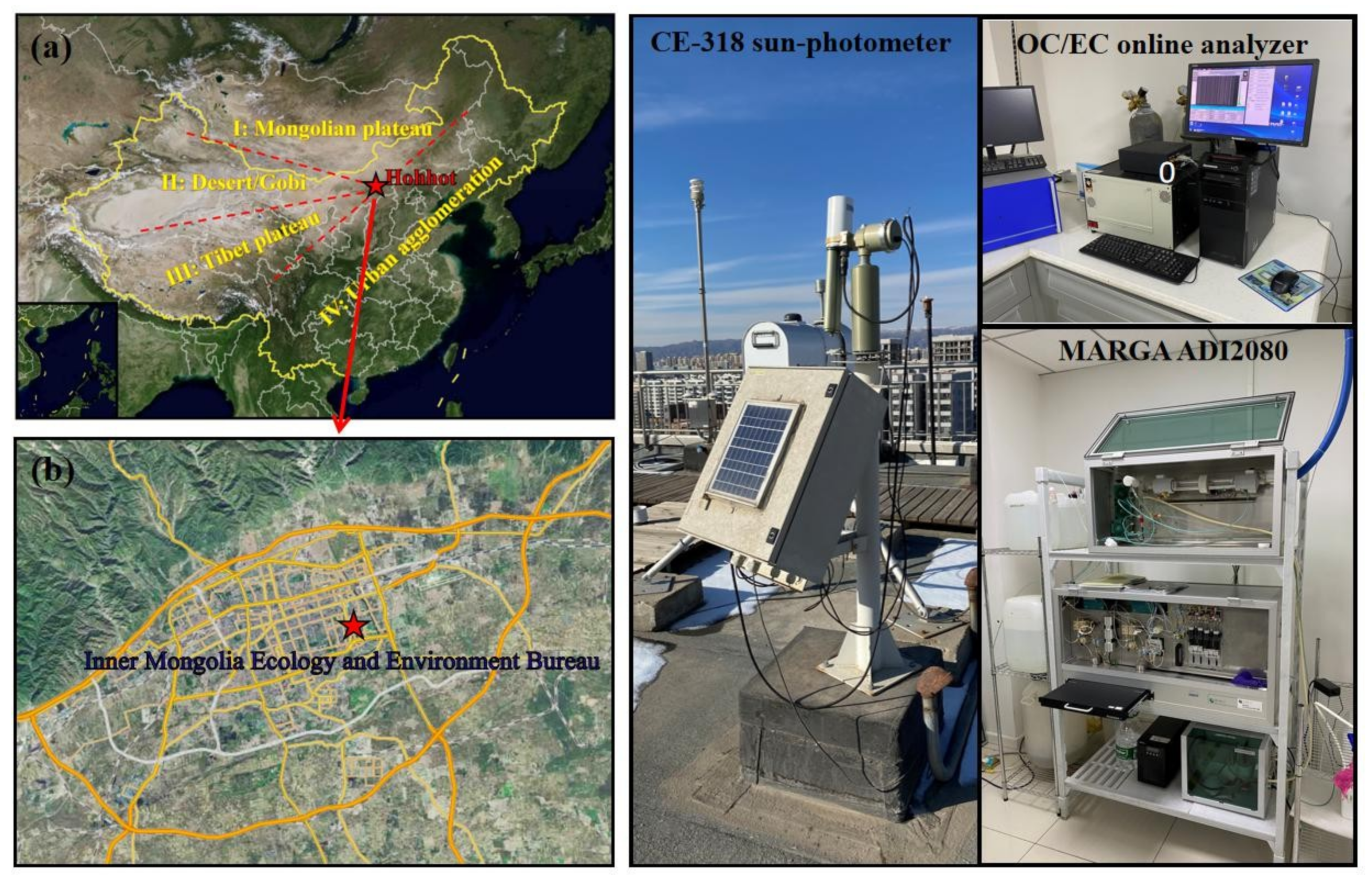
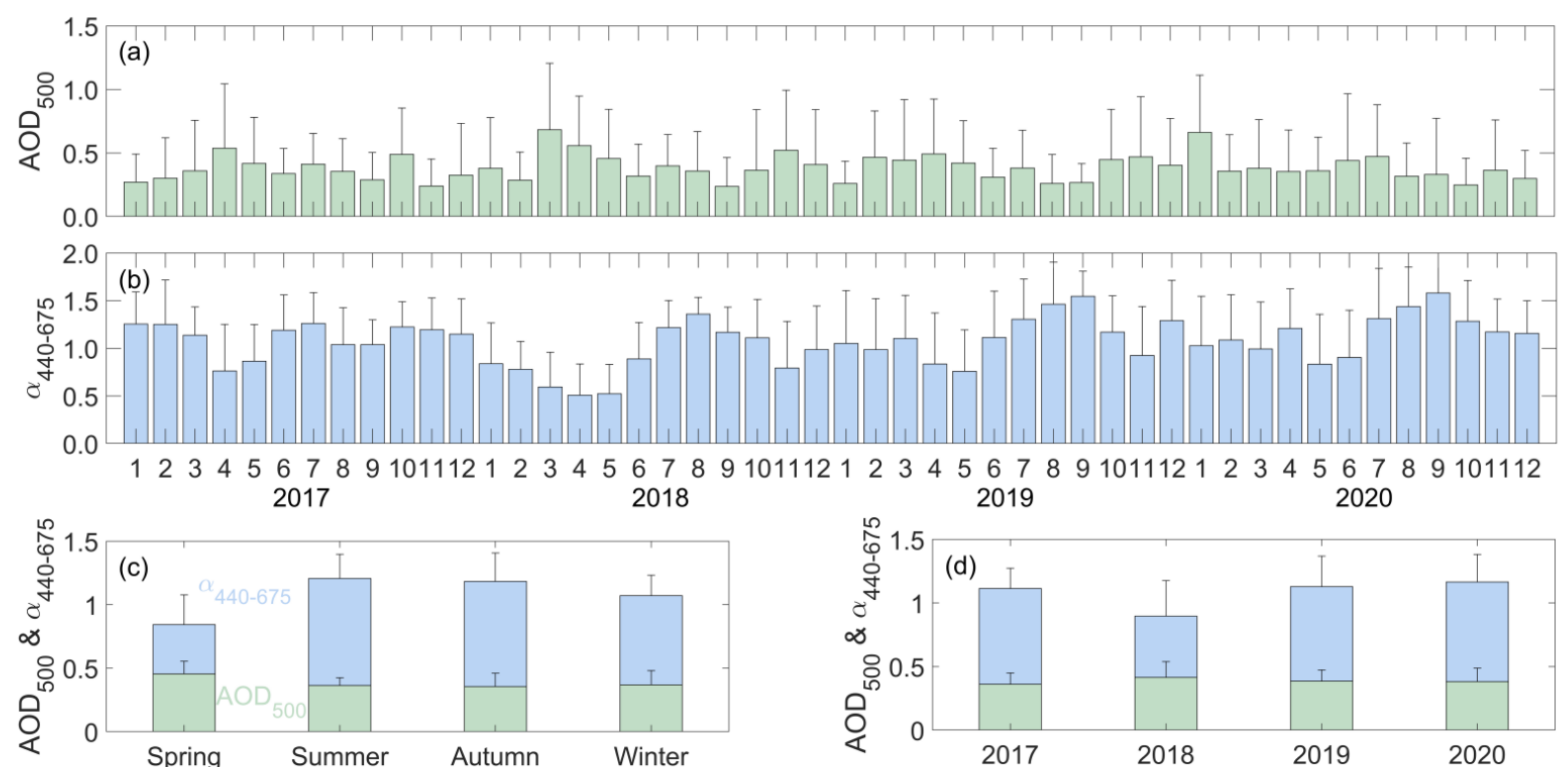
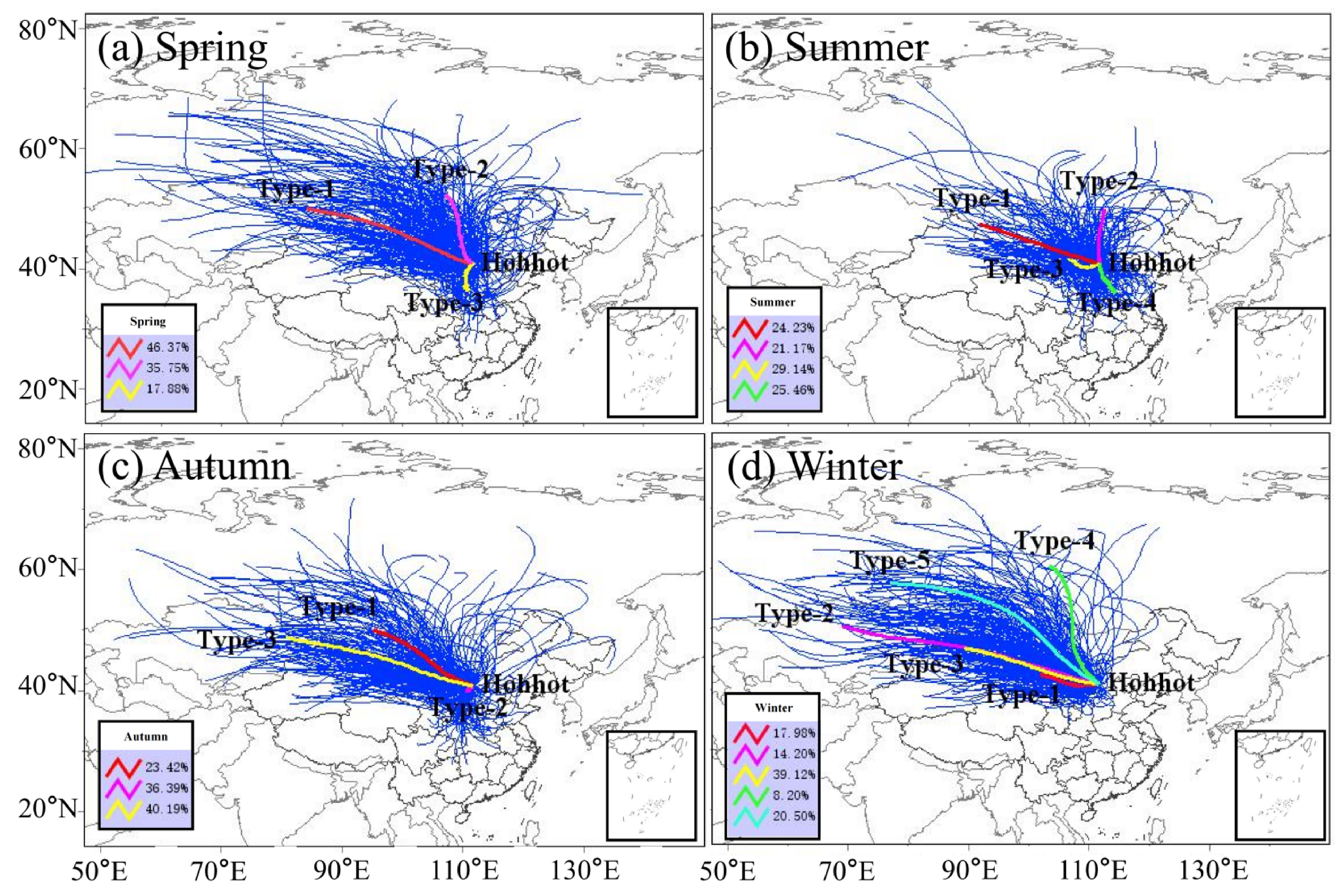
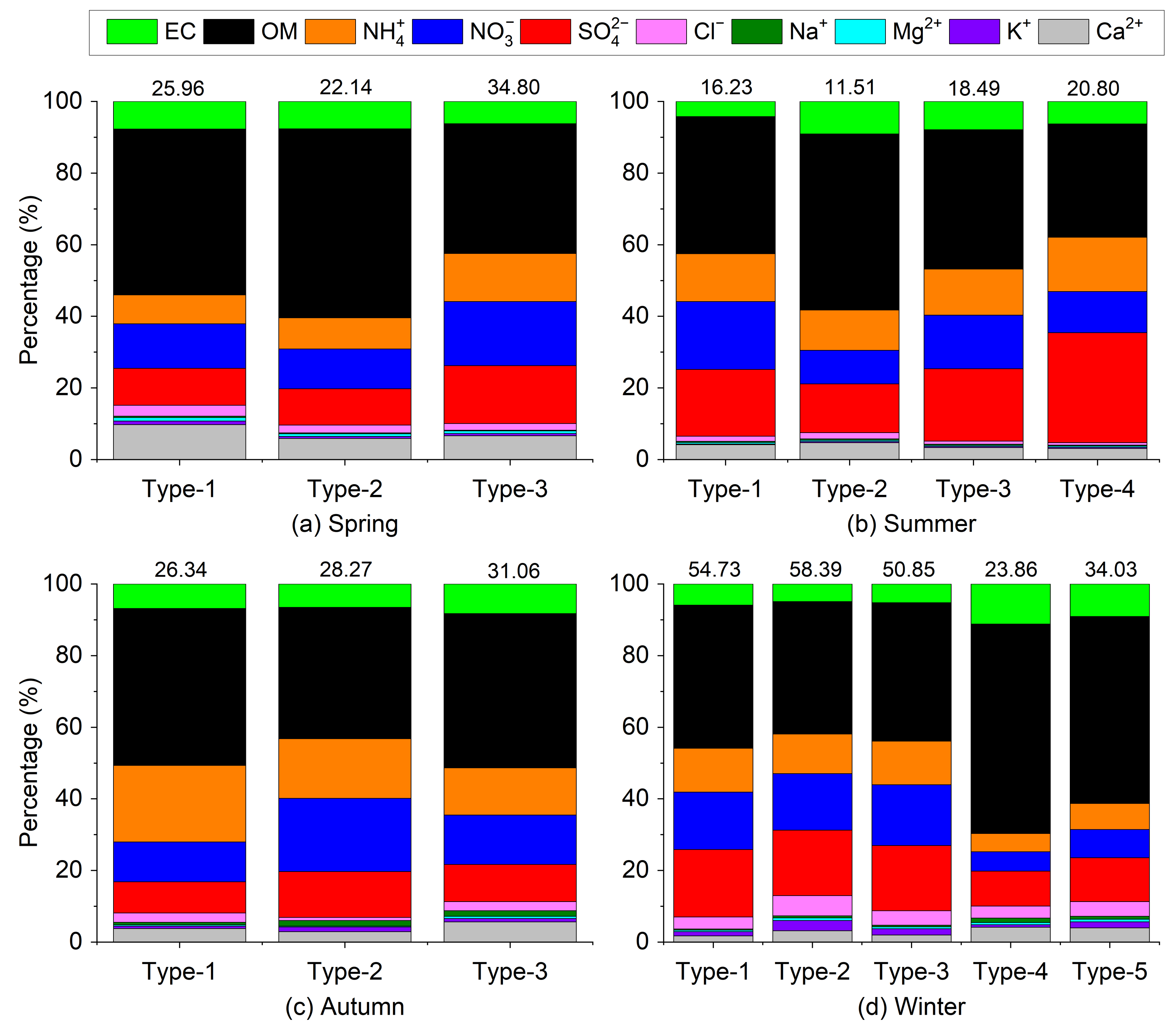

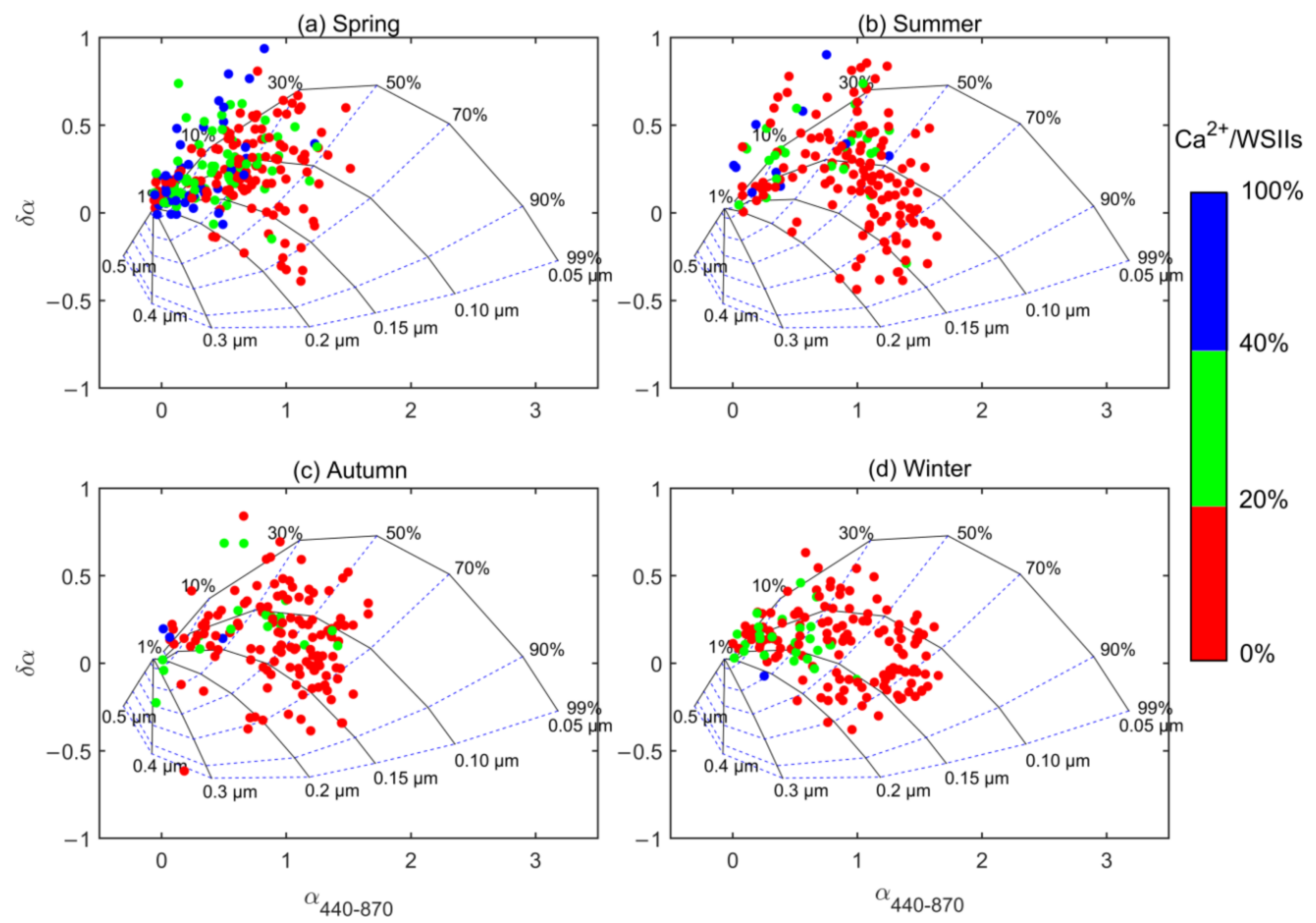
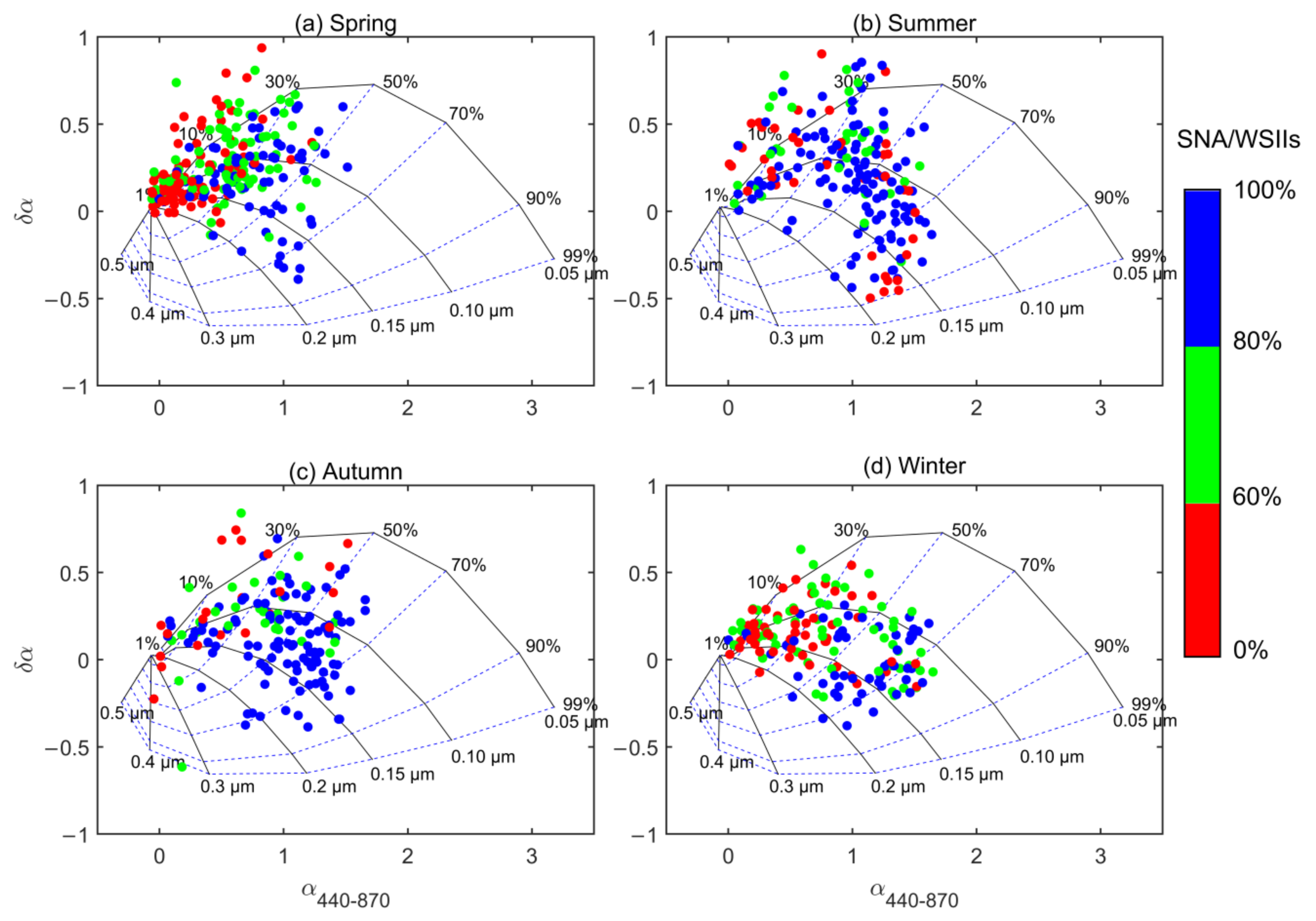

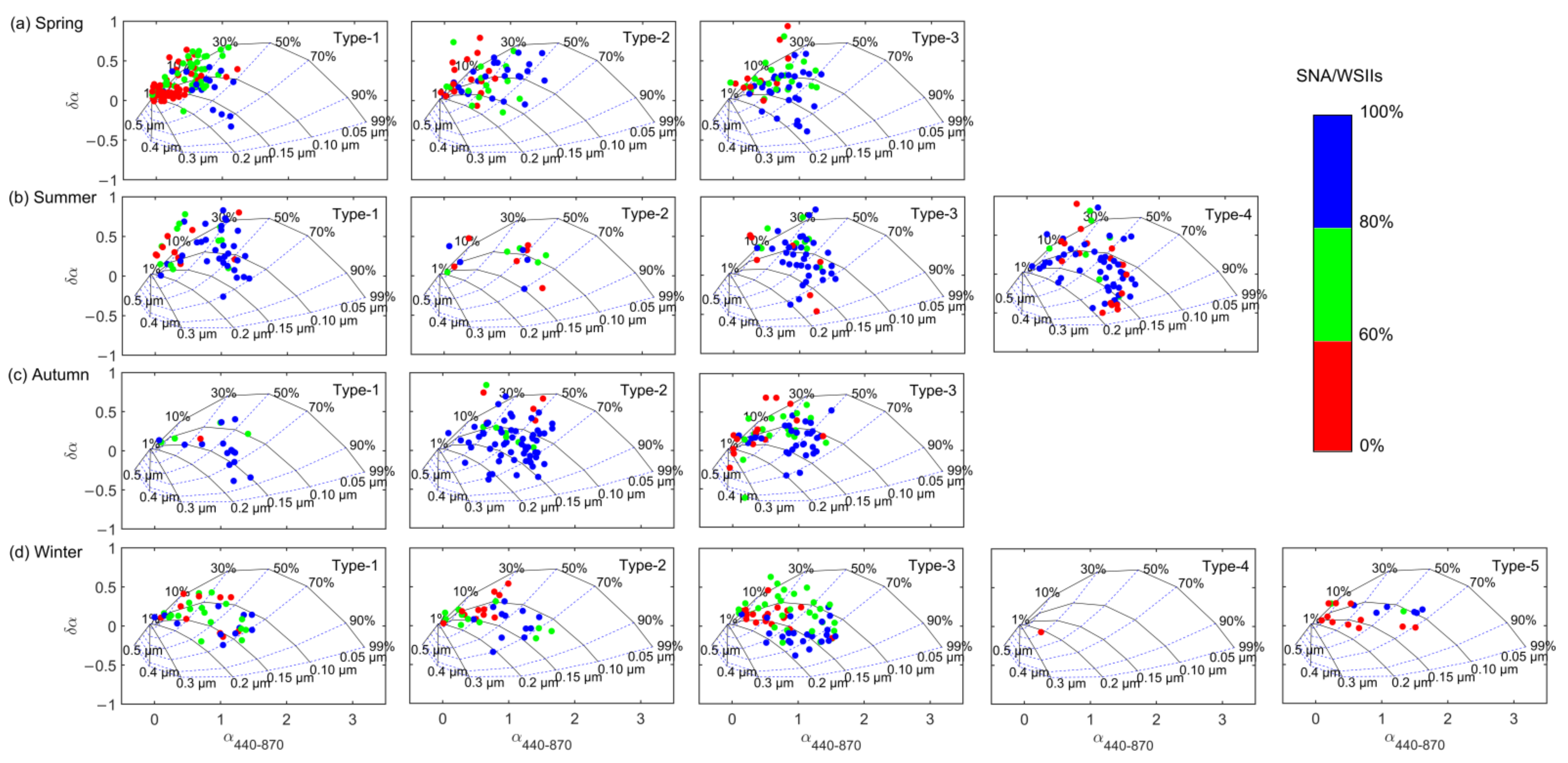
| Type-1 | Type-2 | Type-3 | Type-4 | Type-5 | ||
|---|---|---|---|---|---|---|
| Spring | Origin | Kazakhstan/Xinjiang Province | Mongolia | Shaanxi Province | - | - |
| Direction/ distance | Northwest/Long | North/Medium | South/Short | - | - | |
| Percentage | 46.37% | 35.75% | 17.88% | - | - | |
| AOD500 | 0.45 ± 0.40 | 0.30 ± 0.29 | 0.78 ± 0.46 | - | - | |
| α440-675 | 0.73 ± 0.47 | 1.02 ± 0.48 | 0.72 ± 0.36 | - | - | |
| WS (m s−1) | 2.95 ± 0.96 | 2.87 ± 1.04 | 2.36 ± 0.68 | |||
| Summer | Origin | Mongolia | Mongolia | Inner Mongolia | Shanxi and Henan Provinces | - |
| Direction/distance | Northwest/Long | North/Medium | Northwest/Short | South/Short | - | |
| Percentage | 24.23% | 21.17% | 29.14% | 25.46% | - | |
| AOD500 | 0.29 ± 0.17 | 0.20 ± 0.15 | 0.31 ± 0.19 | 0.65 ± 0.42 | - | |
| α440-675 | 1.08 ± 0.48 | 1.37 ± 0.47 | 1.27 ± 0.38 | 1.14 ± 0.39 | - | |
| WS (m s−1) | 2.24 ± 0.68 | 2.49 ± 0.86 | 2.06 ± 0.64 | 1.98 ± 0.47 | ||
| Autumn | Origin | Mongolia | Inner Mongolia | Kazakhstan | - | - |
| Direction/ distance | Northwest/Medium | Local | West/Long | - | - | |
| Percentage | 23.42% | 36.29% | 40.19% | - | - | |
| AOD500 | 0.24 ± 0.29 | 0.46 ± 0.41 | 0.33 ± 0.35 | - | - | |
| α440-675 | 1.32 ± 0.40 | 1.26 ± 0.40 | 1.01 ± 0.44 | - | - | |
| WS (m s−1) | 2.16 ± 0.83 | 1.91 ± 0.61 | 2.42 ± 1.05 | |||
| Winter | Origin | Inner Mongolia | Kazakhstan | Xinjiang Province | Russia | Russia |
| Direction/ distance | West/Short | West/Long | West/Medium | North/Long | Northwest/Long | |
| Percentage | 17.98% | 14.20% | 39.12% | 8.20% | 20.50% | |
| AOD500 | 0.52 ± 0.43 | 0.50 ± 0.40 | 0.40 ± 0.35 | 0.13 ± 0.08 | 0.19 ± 0.13 | |
| α440-675 | 1.07 ± 0.48 | 0.89 ± 0.43 | 1.09 ± 0.44 | 1.21 ± 0.42 | 1.11 ± 0.45 | |
| WS (m s−1) | 1.63 ± 0.58 | 1.94 ± 0.79 | 1.79 ± 0.72 | 3.19 ± 1.37 | 2.48 ± 1.11 |
Publisher’s Note: MDPI stays neutral with regard to jurisdictional claims in published maps and institutional affiliations. |
© 2022 by the authors. Licensee MDPI, Basel, Switzerland. This article is an open access article distributed under the terms and conditions of the Creative Commons Attribution (CC BY) license (https://creativecommons.org/licenses/by/4.0/).
Share and Cite
Ma, Y.; Tian, Y.; Ren, Y.; Wang, Z.; Wu, L.; Pan, X.; Ma, Y.; Xin, J. Long-Term (2017–2020) Aerosol Optical Depth Observations in Hohhot City in Mongolian Plateau and the Impacts from Different Types of Aerosol. Atmosphere 2022, 13, 737. https://doi.org/10.3390/atmos13050737
Ma Y, Tian Y, Ren Y, Wang Z, Wu L, Pan X, Ma Y, Xin J. Long-Term (2017–2020) Aerosol Optical Depth Observations in Hohhot City in Mongolian Plateau and the Impacts from Different Types of Aerosol. Atmosphere. 2022; 13(5):737. https://doi.org/10.3390/atmos13050737
Chicago/Turabian StyleMa, Yongjing, Yongli Tian, Yuanzhe Ren, Zifa Wang, Lin Wu, Xiaole Pan, Yining Ma, and Jinyuan Xin. 2022. "Long-Term (2017–2020) Aerosol Optical Depth Observations in Hohhot City in Mongolian Plateau and the Impacts from Different Types of Aerosol" Atmosphere 13, no. 5: 737. https://doi.org/10.3390/atmos13050737
APA StyleMa, Y., Tian, Y., Ren, Y., Wang, Z., Wu, L., Pan, X., Ma, Y., & Xin, J. (2022). Long-Term (2017–2020) Aerosol Optical Depth Observations in Hohhot City in Mongolian Plateau and the Impacts from Different Types of Aerosol. Atmosphere, 13(5), 737. https://doi.org/10.3390/atmos13050737








